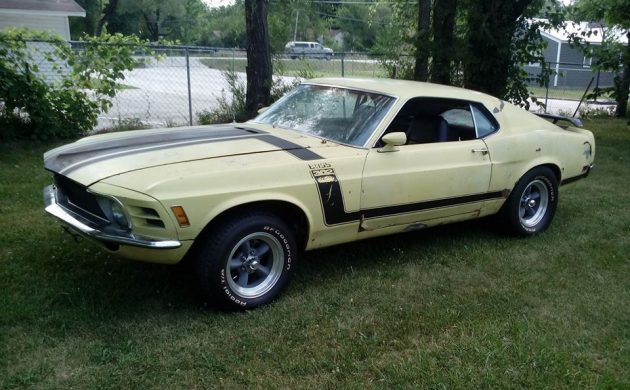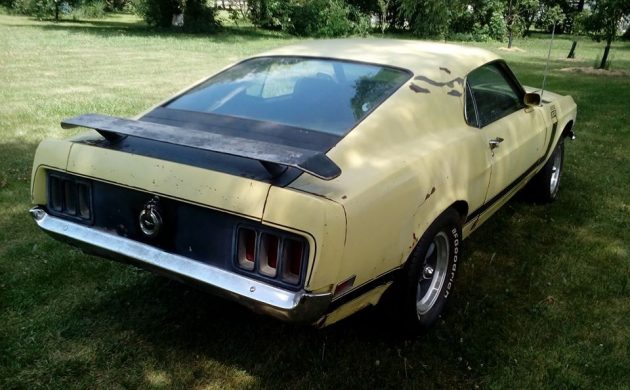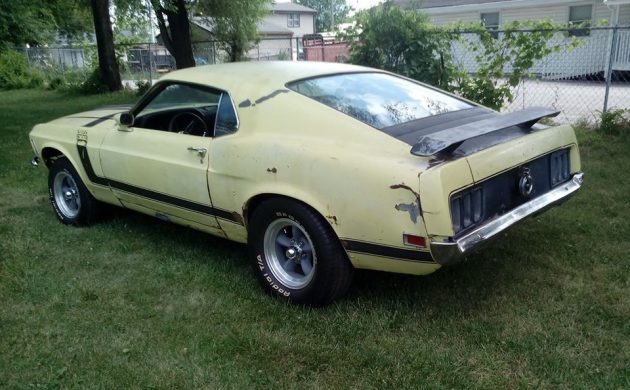Racing is said to improve the breed, and the Mustang Boss 302 owes its very existence to this philosophy. The introduction of the Camaro saw Ford faced with a direct and a worthy competitor to its Mustang. With a view to winning on Sunday and selling on Monday, the Boss 302 was developed by Ford in a bid to trounce the competition on the circuit in Trans-Am competition. While it came close to achieving that racing success in 1969, the 1970 effort bore fruit. It is this racing legacy that has helped to cement the 1970 Boss 302 as a desirable classic. This example will require restoration, but it does appear that the buyer will be commencing the process with a car that possesses strong bones. It is located in Des Moines, Iowa, and has been listed for sale here on Facebook. All you need to do is to hand the owner $25,000, and this Boss could be yours.
There is no doubt that the Competition Yellow Mustang is looking tired, and there will be some rust problems for the buyer to tackle. However, the owner indicates that the vehicle is fundamentally solid. There is the usual collection of rust issues with the floors, the trunk pan, the lower rear quarter panels, and the bottom corners of the doors. Beyond that, this is a classic that appears to be structurally sound. The original rear spoiler is intact, as is the factory tinted glass. The front spoiler is missing, and the exterior chrome will require restoration or replacement. The wheels and tires that are fitted to the car are new, and they are included in the sale. Whether they remain on the vehicle or get swapped out will be a decision for the next owner to make. However, this Boss appears to be off to a promising start.
The engine bay is full of, well, not a lot, really. The owner supplies photos of a collection of engine components, including a block, crankshaft, intake, and valve covers. He states that almost everything is there, but doesn’t specify whether this would make the Mustang a numbers-matching classic. It appears that the car is fitted with a 4-speed manual transmission, but it isn’t clear whether this is the original unit. If the Marti Report is correct, then this Boss should also feature a Traction-Lok rear end. With the Tans-Am series capping maximum engine capacity at 305ci, the Boss squeaked in under that limit at 302ci. This was a special engine, featuring a thin-wall block casting, 4-bolt mains, 10.5:1 compression, and utilizing the cylinder heads for the Cleveland 351 engine. The result of all of this work was a small-block that was a little screamer. It produced an impressive 290hp, and allied to a vehicle weight of 3,227lbs, this allowed the Boss to romp through the ¼ mile in 15 seconds. This Mustang has the potential to achieve those sorts of figures once again. However, that will all be dependent on whether the included engine components are the real deal.
The Mustang’s interior is going to need some work, but it does appear to be complete. The front seats look like they might be wearing relatively new covers, while the original rear seat has been swapped out for a fold-down seat. The dash pad has some cracks, the console and door trims look tired, while the floor will need a new carpet set. Thankfully, all of these parts are readily available, and they also tend to be competitively priced. That is a point worth considering, especially for people who are considering dipping their toe into the classic restoration scene for the first time. There are cars out there that are undoubtedly classics, and some of these could be genuinely stunning cars once restored. One aspect that potential owners can fail to consider for those cars is the availability and cost of parts. Cars like the Mustang and Chevrolet’s Camaro are great examples because the parts for those are readily available, and are generally affordable. However, some classics, while desirable once restored, represent a nightmare during the restoration process due to the scarcity and cost of some parts. If I can give rookies one single piece of advice, it would be to do your homework before committing to a particular car. Restoring a classic car should be an enjoyable and rewarding experience. What you don’t want is a financial and logistical nightmare. That is a situation that is virtually guaranteed to kill any project. That is one scenario that should not impact on this Boss.
This 1970 Mustang Boss 302 is far from perfect, and it will probably require a full nut-and-bolt restoration if it is to be done any justice. At an asking price of $25,000, it is by no means a cheap project car. However, even nicely restored vehicles that aren’t numbers-matching are capable of selling for $70,000 or more. Fixing the rust issues in this car should be a straightforward proposition. If the majority of the supplied engine components are original, then this is a car that has the potential to command a six-figure value once restored. Even if it isn’t numbers-matching, that magical $70,000 figure would seem to leave plenty of room for this classic to be appropriately restored. The result could be a potent and enjoyable car that makes sense financially. That sounds like an attractive proposition.





This was the bomb back in the 70’s but for 25K I would expect to see a motor under the hood!! The body doesn’t look to bad and I know a coyote motor would bolt right in but all things considered with no motor I would not be a dollar over 10K!!!
I don’t think a Coyote will “bolt right in” It can be done but requires a lot of fabricating, and a lot of electrical work.
True, as the writer says, parts are available for this Mustang, and they aren’t pricey. But since it’s a Boss 302, one really doesn’t want to put a bunch of reproduction stuff on it, and finding NOS parts can be an expensive proposition. And, if the new owner wants to maximize the value of his car, he’ll need to go the NOS route, the repop stuff will really adversely impact the value of the car when it’s done if he goes that route.
I just watched a movie today where one of these, in a brighter shade of yellow, was rolled onto its roof. I cringed, shook my head, and hoped it was not a real Boss. Movie was Billionaire Ransom. Anyway, this looks like a pretty easy restoration, with question marks about the engine obviously. I’d go 15-18k for it…
In looking at the paint missing from the sail panels up near the roof on both sides (and photoed in the shade to “hide” reflections) this car may also have been put on it’s top.
Like the fact it has no shaker hood scoop, it just looks better to me that way. Like the wheels too, the fact it has no engine leaves, or shall I say, would have left it wide open for numerous combinations. A real screamer for sure…
The cost and effort to bring this on back to one capable of bringing $70K is huge. You can kiss that value goodbye, despite your efforts if this is not numbrrs matching – more like a 50Kish car. So, details on those parts are paramout. If NOM this is about $15k tops.
Without motor, worth 10,000, and it would not be numbers matching
I’m always amused seeing new tires and wheels on a project that has grown tiresome. Unless you are working on ride height or wheel offset, new tires and wheels are the last thing you need.
Trunk floors look like they should be replaced (get it over with now and forget about them later). Don’t forget the door shells and at the least repair panels for the quarters. I would wouldn’t be surprised to find more rust issues as the project goes on.
Keep the tire dealer’s phone number for when it’s actually ready for the road. These tires may be dry rotted by then. At least you don’t have to pump them up every time you need to move the car.